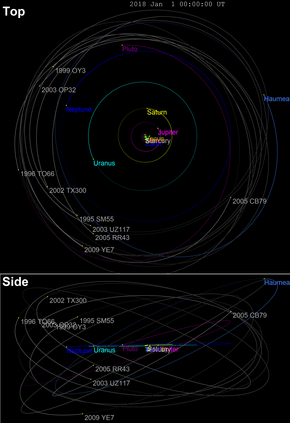
A classical Kuiper belt object, also called a cubewano ( "QB1-o"), is a low-eccentricity Kuiper belt object (KBO) that orbits beyond Neptune and is not controlled by an orbital resonance with Neptune. Cubewanos have orbits with semi-major axes in the 40–50 AU range and, unlike Pluto, do not cross Neptune's orbit. That is, they have low-eccentricity and sometimes low-inclination orbits like the classical planets.
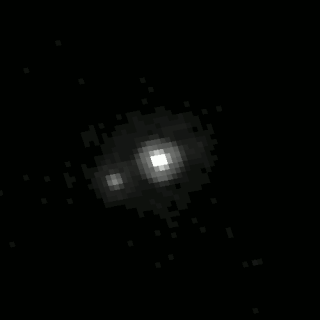
Orcus is a large trans-Neptunian object with a large moon, Vanth. It has a diameter of 870 to 960 km, the size of or somewhat smaller than the Inner Solar System dwarf planet Ceres. Orcus is generally accepted by astronomers as a dwarf planet, although there is some doubt. The surface of Orcus is relatively bright with albedo reaching 23 percent, neutral in color and rich in water ice. The ice is predominantly in crystalline form, which may be related to past cryovolcanic activity. Other compounds like methane or ammonia may also be present on its surface. Orcus was discovered by American astronomers Michael Brown, Chad Trujillo, and David Rabinowitz on 17 February 2004.

Haumea is a dwarf planet located beyond Neptune's orbit. It was discovered in 2004 by a team headed by Mike Brown of Caltech at the Palomar Observatory in the United States and disputably also in 2005 by a team headed by José Luis Ortiz Moreno at the Sierra Nevada Observatory in Spain. On September 17, 2008, it was named after Haumea, the Hawaiian goddess of childbirth, under the expectation by the International Astronomical Union (IAU) that it would prove to be a dwarf planet. Nominal estimates make it the third-largest known trans-Neptunian object, after Eris and Pluto, and approximately the size of Uranus's moon Titania.

Makemake is a dwarf planet and the second-largest of what are known as the classical population of Kuiper belt objects, with a diameter approximately that of Saturn's moon Iapetus, or 60% that of Pluto. It has one known satellite. Its extremely low average temperature, about 40 K (−230 °C), means its surface is covered with methane, ethane, and possibly nitrogen ices.
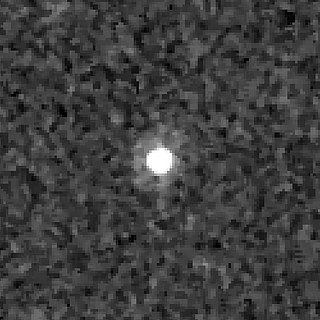
(19308) 1996 TO66 (also written (19308) 1996 TO66) is a trans-Neptunian object that was discovered in 1996 by Chadwick Trujillo, David Jewitt and Jane Luu. Until 20000 Varuna was discovered, it was the second-largest known object in the Kuiper belt, after Pluto.

(55565) 2002 AW197 is a classical, non-resonant trans-Neptunian object from the Kuiper belt in the outermost region of the Solar System, also known as a cubewano. With a likely diameter of at least 700 kilometers (430 miles), it is approximately tied with 2002 MS4 and 2013 FY27 (to within measurement uncertainties) as the largest unnamed object in the Solar System. It was discovered at Palomar Observatory in 2002.

(55636) 2002 TX300 is a bright Kuiper belt object in the outer Solar System estimated to be about 286 kilometres (178 mi) in diameter. It is a large member of the Haumea family that was discovered on 15 October 2002 by the Near-Earth Asteroid Tracking (NEAT) program.

(84922) 2003 VS2 is a trans-Neptunian object discovered by the Near Earth Asteroid Tracking program on 14 November 2003. Like Pluto, it is in a 2:3 orbital resonance with Neptune and is thus a plutino. Analysis of light-curve suggests that it is not a dwarf planet.
(24835) 1995 SM55, provisional designation 1995 SM55, is a trans-Neptunian object and member of the Haumea family that resides in the Kuiper belt, located in the outermost region of the Solar System. It was discovered on 19 September 1995, by American astronomer Nichole Danzl of the Spacewatch program at Kitt Peak National Observatory near Tucson, Arizona, in the United States. It measures approximately 200 kilometers in diameter and was the second-brightest known object in the Kuiper belt, after Pluto, until 1996 TO66 was discovered.

(145453) 2005 RR43, also written as (145453) 2005 RR43, is a trans-Neptunian object (TNO) estimated to be about 250 km in diameter. It was discovered on 9 September 2005 by Andrew Becker, Andrew Puckett and Jeremy Kubica at Apache Point Observatory in Sunspot, New Mexico.

(145451) 2005 RM43, provisionally known as 2005 RM43, is a trans-Neptunian object that resides in the scattered disc region beyond the Kuiper belt. It was discovered on 9 September 2005, by American astronomers Andrew Becker, Andrew Puckett and Jeremy Kubica at Apache Point Observatory in Sunspot, New Mexico. It measures between approximately 500 and 650 kilometers in diameter.

(86047) 1999 OY3, also written as (86047) 1999 OY3, is a trans-Neptunian object that resides in the Kuiper belt beyond Pluto. It was discovered on July 18, 1999, at the Mauna Kea Observatory, Hawaii, USA.

32532 Thereus, provisional designation: 2001 PT13, is a centaur from the outer Solar System, approximately 80 kilometers (50 miles) in diameter. It was discovered on 9 August 2001, by astronomers of the Near-Earth Asteroid Tracking program at the Palomar Observatory in California, United States. This minor planet was named for the phrase thēreios bia 'beastly strength', used to describe centaurs in Greek mythology.

(455502) 2003 UZ413, also written as 2003 UZ413, is a trans-Neptunian object (TNO) with an absolute magnitude of 4.38. It is in a 2:3 orbital resonance with Neptune, thus it is classified as a plutino. There are indications it may be dense enough to be a dwarf planet. It was given the minor planet number 455502 on 22 February 2016.

(202421) 2005 UQ513, also written as 2005 UQ513, is a cubewano with an absolute magnitude of 3.97. Its spectrum has a weak signature of absorption by water ice. Like Quaoar, it has a very red spectrum, which indicates that its surface probably contains many complex, processed organic molecules. Its light curve shows variations of Δm=0.3 mag, but no period has been determined.
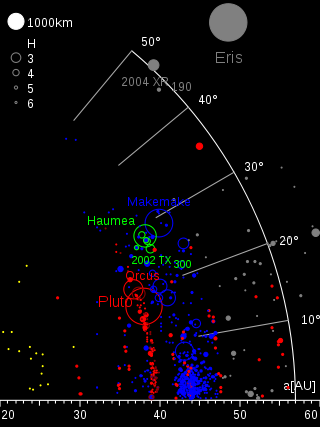
The Haumea or Haumean family is the only identified trans-Neptunian collisional family; that is, the only group of trans-Neptunian objects (TNOs) with similar orbital parameters and spectra that suggest they originated in the disruptive impact of a progenitor body. Calculations indicate that it is probably the only trans-Neptunian collisional family. Members are known as Haumeids.
(144897) 2004 UX10 is a Kuiper-belt object. It has a diameter of about 360 kilometres (220 mi) and was discovered by Andrew Becker, Andrew Puckett and Jeremy Kubica on 20 October 2004 at Apache Point Observatory in Sunspot, New Mexico. The object is classified as a cubewano. It is near a 2:3 resonance with Neptune.
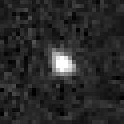
(612620) 2003 SQ317 is a classical trans-Neptunian object and member of Haumea family from the Kuiper belt located in the outermost regions of the Solar System, approximately 300 kilometers in diameter. It was first observed on 23 September 2003, by astronomers of the Canada–France Ecliptic Plane Survey at Mauna Kea Observatories on Hawaii. The surface of 2003 SQ317 is made of water ice.

(416400) 2003 UZ117 is a trans-Neptunian object and suspected member of the Haumea family, located in the Kuiper belt in the outermost region of the Solar System. It was discovered on 24 October 2003, by astronomers of the Spacewatch survey project at Kitt Peak Observatory, Arizona. The object may also be a non-resonant cubewano.
